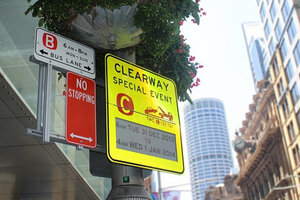How Australia’s new e-ink traffic signs save on energy, money, and confusion
Authorities in Sydney have introduced solar-powered traffic signs to provide customized information based on the time of day.

A traffic sign in Australia displays information in electronic ink, a technology mostly recognized from e-book readers and smartwatches. Sydney authorities rolled out about 100 of these signs this month, the first city to adopt such technology.
Courtesy of Visionect
Self-driving cars. “Smart” headlights. What will motorists get next?
In Australia, it’s going to be new traffic signs: Solar-powered boards where real-time information is updated throughout the day with the use of electronic ink, to be exact.
After a successful trial in Sydney’s central business district, officials this month rolled out about 100 signs across the city to steer traffic and clear up cluttered parking directives, according to City Lab.
Sydney is the world's first city to adopt electronic ink for traffic purposes, a technology mainly recognized from e-book readers and smartwatches, according to the transport department’s partner, Slovenian tech company Visionect.
"The technology came about through staff who saw the potential of e-reader technology to display real-time information about clearways to manage traffic flows during special events," an Australian Road and Maritime Services (RMS) spokesperson told Mashable Australia.
Using a 3G-connected server, the RMS will customize information to guide motorists based on special events and the time of day. Instead of having multiple signs designating parking for different hours, for instance, officials will be able to update each board remotely.
Nighttime lights and protective devices have also been added to increase visibility and deter hackers. Tampering detection software and location coordinates would allow "road services to react quickly should any of the signs be damaged for whatever reason," said Visionect.
Other cities have had to contend with their electronic traffic signs being hacked. This June in San Francisco, public works signs were mysteriously changed to cheer on the Golden State Warriors, reported SF Gate.
E-ink signs can also save tax dollars ordinarily spent on temporary road signs.
Los Angeles, for example, puts up more than 500,000 temporary parking restrictions signs every year, reported city officials in July 2014, at a cost of about $9.5 million. E-ink signs, "easily customizable via cellular networks," will dramatically cut those costs, says Visionect.
"LA’s situation with temp signs is special in that about half are for filming purposes, but still, that’s a lot of moolah for ephemeral objects," wrote City Lab’s John Metcalfe.
The solar-powered signs aren't just green, they're also remarkably efficient, say designers."The hardware components are managed by server software programmed to ‘wake up’ the sign for certain prescheduled windows of time," said Rok Zalar, Visionect’s head of product development. "Outside of the ‘waking’ time, the traffic signs use no power."

